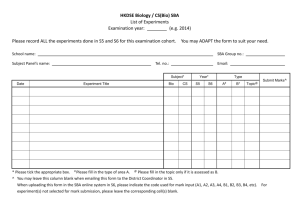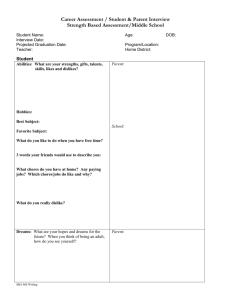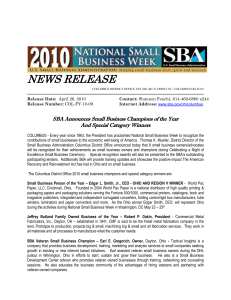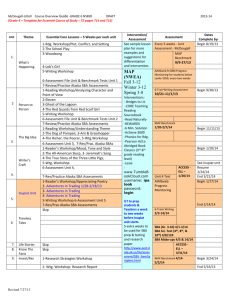Suggested Briefs Template
advertisement
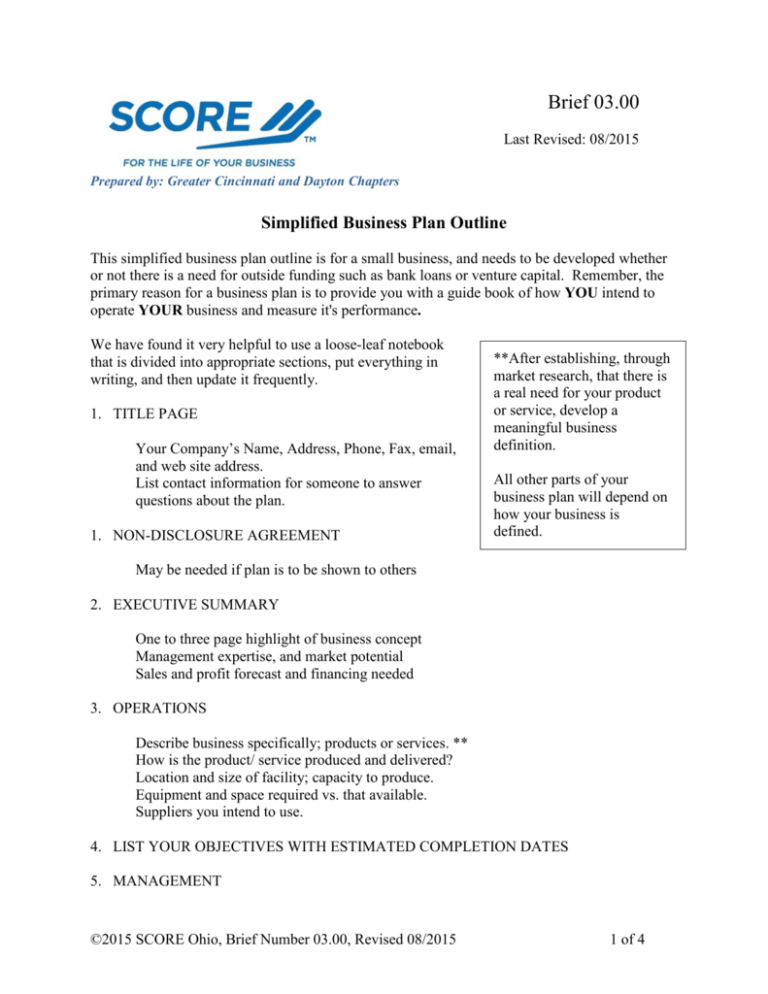
Brief 03.00 Last Revised: 08/2015 Prepared by: Greater Cincinnati and Dayton Chapters Simplified Business Plan Outline This simplified business plan outline is for a small business, and needs to be developed whether or not there is a need for outside funding such as bank loans or venture capital. Remember, the primary reason for a business plan is to provide you with a guide book of how YOU intend to operate YOUR business and measure it's performance. We have found it very helpful to use a loose-leaf notebook that is divided into appropriate sections, put everything in writing, and then update it frequently. 1. TITLE PAGE Your Company’s Name, Address, Phone, Fax, email, and web site address. List contact information for someone to answer questions about the plan. 1. NON-DISCLOSURE AGREEMENT **After establishing, through market research, that there is a real need for your product or service, develop a meaningful business definition. All other parts of your business plan will depend on how your business is defined. May be needed if plan is to be shown to others 2. EXECUTIVE SUMMARY One to three page highlight of business concept Management expertise, and market potential Sales and profit forecast and financing needed 3. OPERATIONS Describe business specifically; products or services. ** How is the product/ service produced and delivered? Location and size of facility; capacity to produce. Equipment and space required vs. that available. Suppliers you intend to use. 4. LIST YOUR OBJECTIVES WITH ESTIMATED COMPLETION DATES 5. MANAGEMENT ©2015 SCORE Ohio, Brief Number 03.00, Revised 08/2015 1 of 4 Type of organization: sole proprietorship, partnership, LLC, or corporation. List manager(s) names, addresses, and phone numbers Describe each manager's experience and expertise. List the duties of each manager; including job descriptions. Show the number of employees. 6. MARKETING Describe your target segment. List primary competitors; their strengths/ weaknesses. Determine your unique competitive advantages. Price your product or services. Apportion funds for advertising, business cards, sales literature. Decide how contacts will be made. Decide who will make them. 7. FINANCIAL Develop budgets, projected cash flow, profit/ loss statements and balance sheets. Estimate funds required for your business and what sources you may approach. Determine insurance needs, and price estimates for appropriate coverage. Open a separate bank account just for the business. 8. OTHER Hire, on a per hour basis, an accountant and lawyer Acquire all necessary licenses and permits, make sure you know zoning requirements. Get to know local bankers, and choose one. More Detail on the Plan Every business can benefit from the preparation of a carefully written plan. The main purpose for writing that plan is to serve as a working guide for the business. It is a living document that should be referred to regularly and updated periodically. Here are some suggestions on the steps to be taken in the preparation of a business plan: Many consider the executive summary to be the most important part of the plan because it is what investors and lenders read first. It is the "sales pitch” through which an investor will be convinced to spend more time on the plan itself. The executive summary should be as short as possible and should not exceed three pages. It should be a concise and clear highlight of what the company is all about and what's in it for the investor. It is a concise summary of the details of the body of the business plan. The executive summary should be written last after completing the other sections of the plan. ©2015 SCORE Ohio, Brief Number 03.00, Revised 08/2015 2 of 4 A key starting point is to describe your business venture. The description should be specific and focused. Do not describe too broad a range of activities, especially if you are a sole proprietor starting up a business. You are just one person with all the responsibilities. Everything in the business plan will be based on or be influenced by what you decide the business is to be. Describe realistic goals and how they will be reached (specific actions in steps, time-phased, measurable, and the designated responsible person). Defining your target market relates directly to the description of your business. You must have a product or service that fills a unique need in order to attract customers. You will need to find out about the trends of your market, its potential customers, your competition, and the best ways to reach your market. The marketing plan is the basis for the business and must describe specific goals supported by facts and logic: size of market, strength of competition, pricing and planned competitive edge. You may wish to talk to similar businesses who are not located in your market area and who will not, consequently, view you as a competitor. The financial section has been called "The Language of Business." It is essential to understand the numbers to know how your business is doing. If you are just starting out, you may be able to handle setting up the financial record keeping yourself. SCORE has some excellent briefs that explain financial documents. SCORE counselors also are ready to help on this and other aspects of your plan. Whether you do the financial portion yourself or contract it to an accounting/ tax firm, understanding the numbers are vital. Of all the financial statements, cash flow is probably the most important. Done properly, it will predict whether or not you will have sufficient funds to meet predicted future needs for cash. Realistic financial projections must clearly show viability of the business. A cash flow projection is solid evidence to prove the plan. General practices are: • The business plan, exclusive of the appendix, could be about 10 to 15 pages in length, probably not more than 20 pages. Supporting data should be placed in the appendix. • Once the plan has been completed, go over it again to make sure it all makes sense. • A set of measurable objectives should also be included; any objective you want to accomplish in the short term - - say a year or two. Do this after completing the other parts of your plan. Other sources you may find useful include: For a Business Plan guide from SBA: https://www.sba.gov/writing-business-plan For a Business Plan of 6-12 pages, see: http://www.rogercohen.com/business_plan_outline.pdf ©2015 SCORE Ohio, Brief Number 03.00, Revised 08/2015 3 of 4 For sample business plans, see: http://www.bplans.com/sample_business_plans.cfm Other Useful References: SCORE Cincinnati https://greatercincinnati.score.org/ SCORE Dayton http://www.daytonscore.org/ SCORE National http://www.score.org/ SBA http://www.sba.gov/ If you would like to request a Cincinnati SCORE counselor please click here, for a Dayton counselor click here Disclaimer The information contained in these briefs is for general information only. While we endeavor to keep the information up to date and correct, we make no representations or warranties of any kind, express or implied, about the completeness, accuracy, reliability, suitability or availability with respect to the information, products, services, or related graphics contained in the briefs Through these briefs you may be able to link to other websites which are not under the control of SCORE therefore the inclusion of any links does not necessarily imply a recommendation or endorse the views expressed within them. Any reference from SCORE to a specific commercial product, process or service does not constitute or imply an endorsement by SCORE, SBA, SCORE Chapter 34, SCORE Chapter 107, or the United States Government of the product, process, or service or its producer or provider. ©2015 SCORE Ohio, Brief Number 03.00, Revised 08/2015 4 of 4
